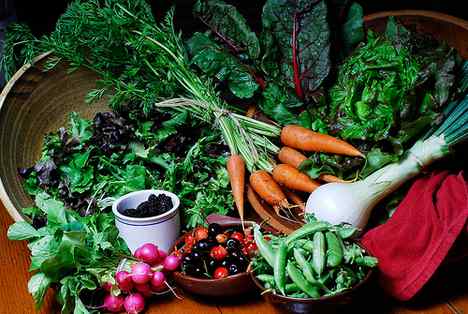My most recent ‘wow’ moments have been triggered by all the wonderful things I’ve been learning about dark, green leafy vegetables (also known as leafy greens, salad greens, edible plant leaves, etc). These nutrient dense, low calorie foods are an essential part of our diet. A quick research into this unpopular group of foods will reveal that greens are filled with vitamins, minerals, and antioxidants. Leafy veggies are an excellent source of vitamins C and K, and minerals like calcium and iron, while being our dietary source for chlorophyll, also known as liquid sunshine. But, even with this knowledge available, most people won’t even eat the few salad leaves that are used to garnish their plate when dining out, much less consciously create meals that include healthy servings of the leafy edibles. So, how will you get your children to like their greens?
Model
The first and most important thing we need to do, as parents, is to model the behaviour and attitudes that we want to see in our children. The earlier in life we can show them healthy habits, the better. You have to allow them see that you enjoy your greens. Which means that if you don’t, it’s time to change that. So, a great way to start is by planting some greens together. Aside from the economical benefits of having your own backyard or balcony garden, you will avoid the toxic chemicals that so many commercially grown produce is treated with. But, most importantly, your child will be enthused to eat something that they have grown from seed to plate, especially if you encourage and applaud them through the process. Just being able to brag that they have grown their own food, will help to build their appetite.
Children also enjoy doing the things they see their parents do and making a meal is one of those things. This is why inviting your child to help you prepare dishes with greens in them, is an excellent strategy. Let them help to chop, shred or blend. I hold my 12-month-old’s tiny palm against the blender button to make green smoothies and have her drop the ingredients into the jar as well. The delight on her face and the eagerness to gulp down the emerald beverage is something to behold. It’s even more important that we don’t send mixed messages to our little ones by telling them to ‘eat your salad’ while we avoid the salad bowl or stuff unhealthy foods into our mouths. So, you will need to partake of greens together. Don’t try to make your child eat anything that you are not willing to eat with them and in front of them.
Manage
Now, sometimes the horse is already through the gate and your child is already a picky eater or is developing the aptitudes of a skilled lawyer or charismatic politician when it comes to deciding what they will and will not eat. This is where our role as Home and Family Manager kicks in. You will have to install and enforce some family dining rules – that apply to everyone, not just the children. Some of the effective food laws that other parents have used are:
1. Dislikes first, favourites after.
When it’s time to eat, the only thing that goes on the plate is the greens. Once the greens are all eaten, then the other elements of the meal may be served. This is very similar to how a multi-course meal is served, where the salad usually comes first.
2. No snacks without finishing main meals.
Your child may protest and insist that they will not eat what has been placed onto their plate. Then hours later, you give them a snack because they are hungry. But, we need to teach our children that treats and pleasantries come after the not-so-pleasant things in life, and that they won’t be rewarded for defiance. Many life principles and attitudes are caught and taught through the way we interact with food. So, place the uneaten portions of their meal into a storage container and make sure it’s available for the next time they want something to eat. They will learn (1) to eat their greens and (2) that life’s problems don’t disappear by ignoring or avoiding them.
3. Trial period.
Agree that all new or disliked foods must go through a trial period. Your child must eat at least 1 spoonful a day, everyday, for two weeks. You may even promise a reward for the successful completion of the trial period. Scientific research and my personal experience have proven that at the end of this two-week period, even a protesting husband, will volunteer to eat and even request the trial foods that were previously disliked. Mind you, only one food item should be put through trial period at a time. They should enjoy the comforts of the other foods they like during this trial.
Mix &Â Mesmerise
But, at the end of the day, the main reason we eat is because we enjoy the flavours, textures and appearance of food. Otherwise, we would have long agreed to receive our daily nutrient requirements through ‘blinged-out’ IV tubes. So, it is also a great idea to make the greens taste amazing! You can start by adding greens to your favourite recipes and then later on trying out dishes that are primarily about the leafy veggies. Some excellent choices for mixing in greens are fruit smoothies and fruit juices, snacks and appetizers like kale chips, spinach dip or cabbage spring rolls. Your stews & meaty dishes, like lasagna or burgers can become hearty hosts for shredded leafy greens without negatively affecting the texture or taste of the dish. Of course, we also eat with our eyes, so creating dishes with edible faces (by arranging the food on the plate to resemble a smiley face) is a sure winner. But, nothing can compare to sneaking in the dark, green leafy vegetables into frozen desserts, like green smoothie popsicles and mint chip kale ice cream, or into baked goodies like spinach muffins or Jamaican-style callaloo (amaranth) patties. There are so many ways to mesmerise and tantalize their appetites and taste buds. So, let your creative and sneaky juices flow.
Do you have other ideas for getting your child to love greens?
Didan Ashanta is a natural living enthusiast who blogs at DidanAshanta.com. A native of Jamaica, she currently lives in Tokyo with her husband and 1-year-old daughter.
About Didan Ashanta
Didan Ashanta is the author of "Jamaican Green Smoothies" and a LifeDesigner who blogs about eating your way to vibrant health at DidanAshanta.com. A native of Jamaica, she currently lives in the Tokyo, Japan with her husband and 3-yr-old daughter.













